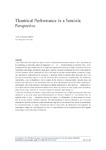Mostrar o rexistro simple do ítem
Theatrical performance in a semiotic perspective
| dc.contributor.author | Aleksandrov, Ivaylo | es_ES |
| dc.date.accessioned | 2014-10-02T12:31:16Z | |
| dc.date.available | 2014-10-02T12:31:16Z | |
| dc.date.issued | 2012 | es_ES |
| dc.identifier.citation | Culture of communication / Communication of culture, 2012: 211-219. ISBN: 978-84-9749-522-6 | es_ES |
| dc.identifier.isbn | 978-84-9749-522-6 | es_ES |
| dc.identifier.uri | http://hdl.handle.net/2183/13309 | |
| dc.description.abstract | [Abstract] Every thèatralitè developed an open system of transformation/transmutation or that transmutation of something in something other (in Bogatyrev 1971: 31 — transformation in different form) which systematized the sign components on the stage and organized the creation of stage semiosis by the actor, transformed into image, through the stage space, costume, musical environment up to the communication with the spectator and his interpretation. This work keeps an attitude towards theatre, as semiotic system, has appeared as configuration by functions; a structure which illustrated other structures and in its own multifunctionality requires a specific communicative environment, representation and aesthetical functionality, what is transform it into a system. In the process of communication between stage and audience that dialectics of the relationships between actor and spectator creates the basic component of performance, and, in the process of representation, theatre manifested its basic function — construction of the architectonics of theater semiosis or whole of this, which we divided on: actor’s play and transmutation (stage figure), stage architecture, costume, musical environment, light design, etc. In that performativity the theatre representation are constructed by a triple-componential utterance, configured by the actor, stage figure (transmutation) and dramatic character or if we defined it by the semiotic point of view — interaction between the subject of performance, its basic theme or concept and the purely authors utterance (speech). The representation of persona dramatica, as a structural combination from the autonomous and informational sign structures, characterized the art of performance as a representational, in a sense of presented; and in a same time, the performance has appeared the meaningless images and from that point of view, it is representative art as a combination of these appears on the stage, even in the sense of notations. | es_ES |
| dc.language.iso | eng | es_ES |
| dc.publisher | Universidade da Coruña | es_ES |
| dc.title | Theatrical performance in a semiotic perspective | es_ES |
| dc.type | info:eu-repo/semantics/conferenceObject | es_ES |
| dc.rights.access | info:eu-repo/semantics/openAccess | es_ES |






